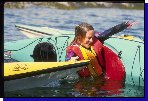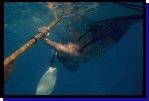
Canoeing
Learning the Basics
 |
A Window on ... Canoeing Learning the Basics |
Your Next StepThis section should be looked after you have checked out the sections, About Canoes and Getting Started. To proceed you should, therefore, know about the basic equipment needed to get started:
 This page outlines some of the basic manoeuvres but learning the basics is best done through a qualified instructor. Safety precautions are essential and as a beginner you should not venture onto the water unless an instructor is nearby, even if you have all the right equipment. The instructor can check that you are handling your canoe properly, he can demonstrate and give you advice about the manoeuvres and, most important of all, he is on hand if anything goes wrong. This page outlines some of the basic manoeuvres but learning the basics is best done through a qualified instructor. Safety precautions are essential and as a beginner you should not venture onto the water unless an instructor is nearby, even if you have all the right equipment. The instructor can check that you are handling your canoe properly, he can demonstrate and give you advice about the manoeuvres and, most important of all, he is on hand if anything goes wrong. Lessons are relatively cheap especially if you attend a group session with your friends and are even cheaper if you book a series of lessons. The hire costs of the equipment are usually included in the cost of the lesson and the centre will provide insurance cover in case of an accident. (See Sources of Information)
| ||||||||||||
Before You Enter the Water! The instructor will show you some basic body moves and advise you about safety precautions. You will practice
getting in and out of your kayak
bracing and relaxing your legs
body or trunk rotation
using your paddle The instructor will show you some basic body moves and advise you about safety precautions. You will practice
getting in and out of your kayak
bracing and relaxing your legs
body or trunk rotation
using your paddle Getting in and out of your kayak is an important manoeuvre. You may need to get out of the canoe when you are in the water so you should be able to do it quickly and safely. You need to be comfortable in your kayak and may need to adjust the footrest to suit your height. Your feet should rest lightly on the foot pedal or bar so that you can brace and relax your legs in a straight position. When your legs are comfortable, make sure you can twist your upper body to the left and the right. Twisting your body is called trunk rotation. You need to do this for power when paddling. Practice using your paddle before you get into the water - it is not as easy as it looks. Keep your hands on top of the paddle with your thumbs underneath and use one hand to control the action. As you twist your body let the blades rotate. | ||||||||||||
Your First Time in the WaterThe instructor will show you:
 You will need to put your kayak into the water first. Keep your paddles nearby ready to pick them up when you are in. You will need to put your kayak into the water first. Keep your paddles nearby ready to pick them up when you are in.Use the paddle strokes you have practised to propel your kayak through the water. Keep the movements steady so that you are well balanced as you move. When you need to get out, paddle towards the shore and use the method for getting that you have practised. Remember to put your paddles on the shore first. Your instructor may ask you to deliberately capsize your boat so that you can practice getting out in an emergency. Don't let go of your kayak or your paddle and leave the kayak upside down. Drag it to the shore first to empty out the water. | ||||||||||||
Basic ManoeuvresWhen you are confident enough to control your canoe your instructor will show you some basic moves:
| ||||||||||||
More Advanced Work When you have mastered the basics, your instructor may introduce you to more advanced techniques that include rescue procedures for yourself or for others. No matter how confident you are in the water, your safety and that of those around you should always be your main priority. When you have mastered the basics, your instructor may introduce you to more advanced techniques that include rescue procedures for yourself or for others. No matter how confident you are in the water, your safety and that of those around you should always be your main priority. You may also be interested to learn some of the techniques used in other forms of canoeing such as whitewater, sprint or sea canoeing. Your instructor will know when you are ready to move onto these specialised areas of canoeing. | ||||||||||||
| ||||||||||||
|
| ||||||||||||